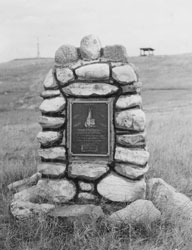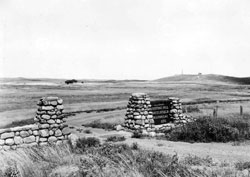We’ve launched a new web portal! Visit findhistory.nd.gov to search our collections.
Due to a road closure, the Killdeer Mountain Battlefield State Historic Site is temporarily closed.
 The light of the following day revealed a field of carnage. Dead and wounded men, women, and children lay in the campsite and in the ravine. Tipis stood vacant, or drooped in various stages of destruction. Camp equipment and personal items, tools, utensils, weapons, toys, and injured or dying horses and dogs littered the ground. Injured women protected babies and the little children. As the soldiers looked after the wounded and gathered the dead, Sully moved his camp to the battlefield. While some squads of soldiers patrolled the region searching for escapees, other men were put to work digging graves and destroying the village and Indian possessions.
The light of the following day revealed a field of carnage. Dead and wounded men, women, and children lay in the campsite and in the ravine. Tipis stood vacant, or drooped in various stages of destruction. Camp equipment and personal items, tools, utensils, weapons, toys, and injured or dying horses and dogs littered the ground. Injured women protected babies and the little children. As the soldiers looked after the wounded and gathered the dead, Sully moved his camp to the battlefield. While some squads of soldiers patrolled the region searching for escapees, other men were put to work digging graves and destroying the village and Indian possessions.
During the Battle of Whitestone Hill, 20 soldiers were killed and 38 were wounded. Although there was no accurate count of the Indian casualties, estimates ranged from 100 to 300 dead. In addition, 32 men and 124 women and children were captured. For two days, military patrols guarded against reprisal raids while troops destroyed Indian property. Tipis, buffalo hides, wagons, travois, blankets, and perhaps as much as half million pounds of buffalo meat were stacked and burned. Some of the fires were set over the graves of the soldiers to obscure the location of the burial places. Troops threw pots, kettles, weapons, and other things that would sink, into the lake.
On September 5, one of the scouting details ran into a party of Indians. In the ensuing skirmish, two more white soldiers were killed. The following day, Sully and his army marched south toward their transport on the Missouri River. The Indians, who had escaped the battlefield, scattered over the plains looking for friends and families who could share necessities during the winter months.
Address:
7310 86th Street SE
Kulm, ND 58456
Get Directions
Hours:
Open year round.
Contact Whitestone Hill:
phone: 701.328.3508
Contact SHSND:
phone: 701.328.2666
email: history@nd.gov